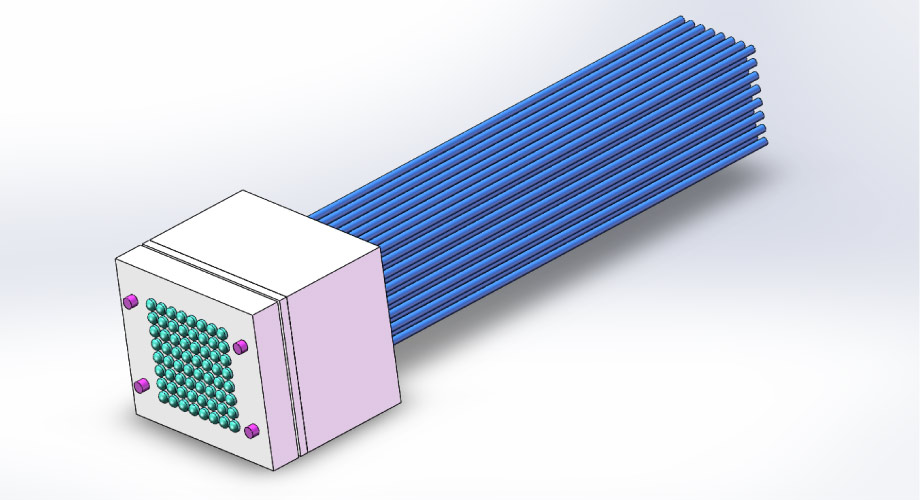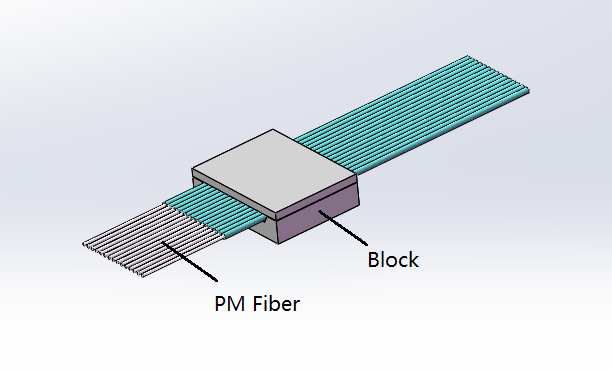Industry News
MT-FA and 2D-FA: The Evolution of Fiber Array Technology
In recent years, fiber optic technology has undergone significant advancements, driving innovations in communication, sensing, and various other industries. At the heart of these innovations is fiber array technology, which enables the efficient coupling and integration of multiple optical fibers in a compact, high-performance package. Two of the most prominent types of fiber array technologies—MT-FA (Multi-fiber Array) and 2D-FA (Two-Dimensional Fiber Array)—have been pivotal in revolutionizing the fiber optic industry. These advanced fiber arrays are engineered to meet the ever-growing demand for high-bandwidth, high-precision, and high-density fiber optic systems.
In this blog, we will explore the evolution of MT-FA and 2D-FA fiber arrays, discussing their key differences, manufacturing techniques, and applications in various fields. Whether you're working in telecommunications, data centers, or fiber optic sensing, understanding these technologies is crucial to leveraging their full potential.
What is Fiber Array Technology?
Before diving into the specifics of MT-FA and 2D-FA, it's important to understand what fiber array technology is and why it's essential for modern fiber optic systems.
A fiber array is a structure that arranges multiple optical fibers into a fixed or customizable configuration, enabling them to be aligned precisely for high-performance applications. Fiber arrays are typically used in optical communication systems, multiplexers, and other systems where multiple fibers need to be efficiently managed and coupled. These arrays are designed to maintain precise spacing between the fibers to ensure optimal signal transmission with minimal loss.
In fiber optic systems, the quality of the fiber array determines the overall system's performance. High precision fiber arrays ensure that the light signals traveling through the fibers are aligned correctly, minimizing signal degradation and maximizing the efficiency of data transmission. The two most advanced types of fiber arrays—MT-FA and 2D-FA—represent the cutting edge of this technology.
MT-FA: Multi-fiber Array Technology
MT-FA (Multi-fiber Array) technology is one of the earliest and most widely used fiber array systems. It is designed to manage a large number of optical fibers in a compact space. The MT-FA fiber array typically consists of multiple optical fibers arranged in a single row or column. This configuration allows for efficient coupling and signal transmission across a wide range of applications, including telecommunications, data centers, and high-performance networking systems.
Key Features of MT-FA Technology
-
High Density and Compact Design
One of the main advantages of MT-FA technology is its ability to pack a large number of fibers into a small, compact array. This high-density configuration makes it ideal for applications where space is limited, such as in fiber optic switches, multiplexers, and telecom equipment. -
Efficient Signal Transmission
The MT-FA array is designed to maintain high precision and alignment between fibers. By ensuring that the fibers are aligned correctly, MT-FA systems minimize signal loss, providing efficient transmission for high-bandwidth applications. -
Scalability
MT-FA systems are highly scalable, making them suitable for both small-scale and large-scale fiber optic systems. They can be customized to support varying numbers of fibers depending on the requirements of the specific application. -
Durability and Reliability
MT-FA fiber arrays are engineered for durability and long-lasting performance. These arrays are built to withstand harsh environmental conditions, including temperature fluctuations and physical stresses, making them highly reliable in mission-critical applications.
Applications of MT-FA Technology
MT-FA technology has been widely adopted in various industries due to its compact design, high density, and efficiency. Some of the key applications of MT-FA fiber arrays include:
- Telecommunications: MT-FA arrays are commonly used in optical multiplexers and demultiplexers, enabling efficient data transmission across long distances.
- Data Centers: MT-FA systems provide the high-density fiber connectivity required for modern data centers, facilitating faster data transfer between servers and storage devices.
- Fiber Optic Sensors: MT-FA technology is also used in fiber optic sensing applications, where precise measurements of temperature, strain, and other environmental factors are essential.
For a deeper look into MT-FA technology and its applications, check out more details at Yilut.com.
2D-FA: Two-Dimensional Fiber Array Technology
While MT-FA arrays are excellent for linear fiber configurations, 2D-FA (Two-Dimensional Fiber Array) technology takes fiber array design to the next level by arranging fibers in a two-dimensional grid or matrix. This allows for a higher degree of flexibility and precision, enabling more sophisticated optical systems. 2D-FA fiber arrays can support not only linear but also two-dimensional fiber layouts, which makes them particularly useful in advanced optical networks and high-precision fiber array systems.
Key Features of 2D-FA Technology

-
Higher Fiber Density
The 2D-FA configuration allows for a higher fiber density compared to MT-FA arrays. This is especially beneficial for applications where large-scale fiber integration is required, such as in multi-core fibers or large data centers. -
Improved Alignment and Performance
The 2D-FA design ensures more precise alignment of fibers, leading to improved signal coupling and reduced insertion loss. This high level of precision makes 2D-FA arrays ideal for high-performance fiber optic systems that demand minimal signal degradation. -
Versatility
2D-FA arrays can be adapted to a wide range of fiber configurations, from simple square grids to more complex geometries. This versatility makes them suitable for a variety of applications, from telecommunications to medical imaging. -
Customizable Design
One of the unique features of 2D-FA technology is its ability to offer highly customizable designs. Depending on the application, the number of fibers and their spacing can be adjusted to optimize system performance.
Applications of 2D-FA Technology
The advanced features of 2D-FA technology make it ideal for applications where higher fiber density and precision are required. Some of the key applications of 2D-FA fiber arrays include:
- High-Performance Optical Networks: 2D-FA arrays are commonly used in optical switching and multiplexing systems for large-scale telecommunications and data networks.
- Medical Imaging: The high precision and customizability of 2D-FA arrays make them suitable for medical applications, such as in optical coherence tomography (OCT) and other diagnostic imaging systems.
- Quantum Computing: As quantum technologies evolve, 2D-FA arrays are playing a critical role in the development of optical interconnects and quantum communication systems.
Comparison of MT-FA and 2D-FA Technologies

To better understand the differences between MT-FA and 2D-FA, let’s compare the two technologies based on several key parameters:
| Feature | MT-FA | 2D-FA |
|---|---|---|
| Fiber Arrangement | Single row or column of fibers | 2D grid or matrix of fibers |
| Fiber Density | Moderate, suitable for compact designs | High, ideal for dense fiber systems |
| Alignment Precision | High, but typically for linear configurations | Higher, allows for complex fiber layouts |
| Scalability | Highly scalable, suitable for many applications | Scalable, but requires more complex designs |
| Applications | Telecommunications, data centers, sensing | Advanced optical networks, medical imaging, quantum computing |
| Cost | Generally lower due to simpler design | Higher due to more complex design and precision |
Both MT-FA and 2D-FA technologies have distinct advantages depending on the application. While MT-FA arrays are perfect for applications that require high-density linear fiber arrays and cost-effective solutions, 2D-FA arrays offer superior performance for high-precision, high-density systems that require flexibility and scalability.
Manufacturing of Fiber Arrays
The production of MT-FA and 2D-FA arrays involves several steps, including fiber alignment, grating application, and packaging. The manufacturing process for both technologies requires high precision to ensure that the fibers are accurately aligned within the array.
- MT-FA Arrays: The fibers are placed in a single row or column, and the array is typically constructed using a precision fixture or mold to ensure correct spacing between the fibers. The fiber ends are polished and packaged into a connector for easy integration into fiber optic systems.
- 2D-FA Arrays: The production of 2D-FA arrays is more complex, as it involves arranging fibers in two dimensions. This requires specialized alignment fixtures and potentially more advanced technologies like micro-lens arrays or active alignment systems.
Conclusion
The evolution of MT-FA and 2D-FA fiber array technologies has transformed the fiber optic industry, enabling the development of high-performance, high-density fiber optic systems that are essential for modern telecommunications, data centers, and sensing applications. Both MT-FA and 2D-FA offer unique advantages, and their use depends on the specific requirements of the application at hand. Whether you need a compact, cost-effective solution like MT-FA or a high-precision, high-density array like 2D-FA, understanding these technologies allows you to make informed decisions in designing and optimizing fiber optic systems.
For more information on fiber array technologies, explore Yilut.com for advanced solutions and insights.
Latest News
-
How Fiber Grating Technology Is Shaping Modern Optical Systems
2025-05-07 -
The funny team building activity in Yilut - Your hard work is more beautiful than the scenery.
2024-10-25 -
YILUT Shines at ECOC EXHIBITION 2023 - We Look Forward to Your Visit!
2023-09-27 -
【CIOE2023】Yilut Tech Invites You to Shenzhen International Optoelectronics Exhibition - A Journey with Light!
2023-08-23 -
Embracing Infinite Possibilities: YILUT Showcasing New Products at NETCOM2023 Exhibition
2023-07-25


